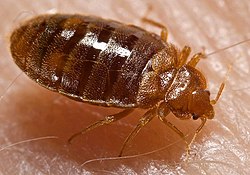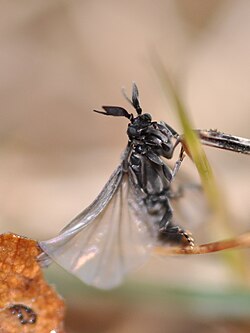Top Qs
Timeline
Chat
Perspective
List of insect orders
From Wikipedia, the free encyclopedia
Remove ads
Insecta is a class of invertebrates that consists of around 30 individual orders.[1] Orders are the fifth taxonomic rank used to classify living organisms, below the rank of class, but above the rank of family.[2] With around 1 million insect species having been formally described and assigned a binomial name, insects are the most diverse group of animals, comprising approximately half of extant species on Earth. The total insect biodiversity has been estimated at around 6 million species.[3][4] The most diverse orders are Coleoptera (beetles), Hymenoptera (wasps, bees, ants and sawflies), Lepidoptera (butterflies and moths), Diptera (flies) and Hemiptera (true bugs).[5] Taxonomists disagree on the exact number of orders, with opinions ranging from 26 to 32 distinct extant orders.[6]

Insecta was originally divided into seven orders in 1758 by Carl Linnaeus in the 10th edition of Systema Naturae. When Insecta was originally described it was split into two informal groups, Paleoptera and Neoptera.[7] Insects that do not have the ability to fold their wings over their abdomen were sorted into Paleoptera, and ones that could (or had an ancestor that could) were sorted into Neoptera.[7] Individual orders were primarily defined by the number and structure of wings, with other factors such as antennae being considered.[8] The classification of insects changes as new discoveries are found, with species regularly shifted around different orders.[9] The most recent order described was the monotypic (an order with only one family) Mantophasmatodea in 2002.[9]
Remove ads
Apterygota
Summarize
Perspective
Apterygota is a paraphyletic (a grouping that consists of the grouping's last common ancestor and some but not all of its descendant lineages) group containing two orders of primitive and wingless insects, historically united on the basis of morphology.[10]
Remove ads
Palaeoptera
Palaeoptera is an infraclass (the taxonomic rank directly below subclass) of insects with 2 existing orders.[18] Wings of Palaeoptera cannot be folded back when they are not being used, and species undergo hemimetaboly (metamorphosis missing one or more stages rather than complete metamorphosis).[19]
Remove ads
Polyneoptera
Summarize
Perspective
Polyneoptera is a group of winged insects that possess four wings, long antennae and mouths specialized for chewing.[22][c] When stationary, their wings are typically folded over their body flat.[23] They are hemimetabolous, hatching as nymphs which gradually acquire their adult morphology through successive moults.[24]
Remove ads
Paraneoptera
Paraneoptera is a superorder of insects that undergo hemimetaboly.[40] Many species are agricultural pests, damaging the plants that they feed on.[41] The lifespan of species in Paraneoptera are short, with some lasting 6 weeks or less.[42]
Remove ads
Holometabola
Summarize
Perspective
Holometabola is a group of insects that are characterized by complete metamorphosis (insects that go through egg, larva, pupa and adult stages).[46] The orders Coleoptera, Hymenoptera, Diptera and Lepidoptera contain the greatest number of species in this group (more than 99%).[46]
Remove ads
Notes
- The author citation (last name and year of the person(s) who originally described the order) is listed under the order name.
- The exact number of species changes as new ones are described; the figures described are based on a 2013 report by Zhi-Qiang Zhang, and orders with more than 100 species are rounded to the nearest hundred.[11]
- Some species in Phasmatodea, Dermaptera and Zoraptera are secondarily wingless having lost their wings during evolution.[22]
- Some parasitic species in alpine regions have lost their wings through evolution.[49]
Remove ads
References
Wikiwand - on
Seamless Wikipedia browsing. On steroids.
Remove ads






























